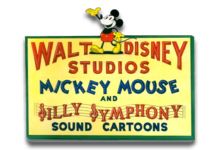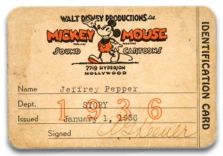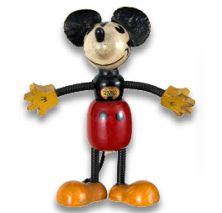With the recent announcement of this year's wave of Disney Treasures DVDs, I thought I would revisit my own wish list of future Treasure sets and also expand on it as well. In a post from January of 2007, I outlined three potential collections; none have yet to be realized and they remain at the top of my request list. For readers of that prior post, please forgive my redundancy in repeating the details of those particular items.

One of the true lost treasures of Disney’s laserdisc era is the
Exclusive Archives Collection of The Three Caballeros and Saludos Amigos. Laserdisc special editions were the real precursors to whole “special features” DVD phenomenon, and the Caballeros/Amigos set was a shining example of the best that format could produce. Beyond the films themselves, the set was filled with an overabundance of supplemental material that would be perfect a
Treasures DVD. The documentary
South of the Border With Disney, screen tests, radio broadcasts, storyboards, concept art, and publicity materials, are among its many highlights. But the real gems of the collection are reconstructions of two abandoned short subjects:
“A Brazilian Symphony: Caxanga,” and
“The Laughing Gauchito.”
Marry this material with a complete set of the studio’s “south of the border” themed shorts, such as
Clown of the Jungle,
Pueblo Pluto,
Pluto and the Armadillo,
The Pelican an the Snipe, and
Contrary Condor, and even throw in the
Blame It on the Samba sequence from
Melody Time for good measure. Then add a healthy dose of Disney’s Latin American public service films, such as the long unseen
The Amazon Awakes and the Careless Charlie series, and you have the makings of a terrific
Treasures product. Unfortunately, the recent mainstream release of the Caballeros Collection DVD makes a Treasures release unlikely any time in the near future.

I continue to advocate for the release of what is a mostly forgotten chapter in the Studio’s history: the
People and Places series of documentary short subjects. Similar in style and format to the
True-Life Adventures, these travelogues employed many of the same talented individuals and earned a number of Oscar accolades as well.
People and Places began with
The Alaskan Eskimo in 1953 and concluded in 1960 with the films
Japan and
The Danube. Studio and animation veteran Ben Sharpteen directed nearly all of the titles in the series. The most famous entry,
Disneyland USA, was released as part of last year's Treasures entry
Disneyland: Secrets, Stories and Magic.

I am a huge fan of the Disneyland-themed Treasures sets, but I feel it's time the focus shifted a bit to the east. An examination of both the concepts and realization of EPCOT would be a wonderful place to start. Starting with the original EPCOT film that appeared on the Treasures
Tomorrowland title, the set could also include the various souvenir videos, and also many of the now long gone attraction films. It would be great to again be able to see items such as the Earth Station film,
Symbiosis,
The Water Engine from World of Motion, and the various original Energy films, including some type of recreation of the now famous Emil Radok designed
Energy: You Make the World Go Round. Other great pieces of obscure EPCOT: the Choose Your Ending sequences from Horizons; the original Seas introductory film, the two animated vignettes also from the Living Seas--
The Animated Atlas of the World and
Suited for the Sea; and the animated educational short
Harold and His Amazing Green Plants, that featured characters from Kitchen Kaberet. Highlights from the numerous EPCOT Educational Media films, and clips from The Disney Channel’s
EPCOT Magazine program would also be great inclusions.

Among the darkest moments in the history of Walt Disney Home Entertainment were the releases of
Make Mine Music and
Melody Time. During the company's pre-Treasures era, its primary focus was pleasing the soccer-mom demographic, resulting in some of the most outrageous and unnecessary censorship ever visited upon classic Disney animation. An entire segment,
The Martins and the Coys, was removed from
Make Mine Music, and the
Pecos Bill sequence in
Melody Time was clumsily re-edited and digitally altered to remove cigarette smoking references. A Disney Treasures restoration of these two films would go a long way to righting those earlier wrongs. There is no doubt an abundance of material residing in the archives to provide for supplemental features, especially relating to such notable segments as
Peter and the Wolf,
The Whale Who Wanted to Sing at the Met,
Johnny Appleseed and
Pecos Bill. A feature profiling the various popular music personalities who participated in the films--among them the Andrews Sisters, Roy Rogers, Jerry Colonna, Nelson Eddy, Dinah Shore and Dennis Day--would also be a welcome addition. And throw in the 1954 sequel to
Casey at the Bat,
Casey Bats Again, for good measure.

If the Treasures series can bring us such notable Disney television-based characters as Davy Crockett, the Swamp Fox and the Scarecrow of Romney Marsh, why for heavens sake not Ludwig Von Drake. He is one the studio's most entertaining personalities yet has long been terribly underrepresented on video and DVD. In his first appearance on September 24, 1961, he, along with Walt Disney, introduced Disney television programing to color, and would go on to be the shows premiere animated character during the 1960s. In addition to that first episode,
An Adventure in Color/Mathmagic Land, the set could include other Von Drake tour de forces such as
Carnival Time,
Fly With Von Drake,
Inside Outer Space,
Von Drake in Spain and
The Hunting Instinct. An extended profile of Von Drake's alter ego, veteran voice artist Paul Frees, would make a great supplemental feature.
Explore the 2719 Hyperion Archives:
Caxanga!
Melody Time
 Posting simultaneously on our sister blog Boom-Pop! is a feature on Victory Gardens, a home front initiative that encouraged citizens to cultivate vegetable gardens to help alleviate food shortages and reduce the need for rationing during World War II. The Victory Garden emerged as one of the more prominent aspects of mid-1940s popular culture, and so it was inevitable that the Walt Disney Studios would in some ways intersect with this pastime of patriotic seed sowing.
Posting simultaneously on our sister blog Boom-Pop! is a feature on Victory Gardens, a home front initiative that encouraged citizens to cultivate vegetable gardens to help alleviate food shortages and reduce the need for rationing during World War II. The Victory Garden emerged as one of the more prominent aspects of mid-1940s popular culture, and so it was inevitable that the Walt Disney Studios would in some ways intersect with this pastime of patriotic seed sowing. Although the Disney Studio never produced a Victory Garden themed cartoon, Walt did lend out two of his biggest stars to participate in Victory Garden promotional efforts. Mickey Mouse was featured on materials for a Green Thumb Contest sponsored by the National Victory Garden Institute in 1944. State war councils sponsored the contest locally. Illinois Mobilizes, the newsletter of the Illinois War Council, noted in their July 1, 1944 issue, "Each entrant receives a contest record book, with a cover especially designed by Walt Disney to be used for keeping a record of planting and harvesting."
Although the Disney Studio never produced a Victory Garden themed cartoon, Walt did lend out two of his biggest stars to participate in Victory Garden promotional efforts. Mickey Mouse was featured on materials for a Green Thumb Contest sponsored by the National Victory Garden Institute in 1944. State war councils sponsored the contest locally. Illinois Mobilizes, the newsletter of the Illinois War Council, noted in their July 1, 1944 issue, "Each entrant receives a contest record book, with a cover especially designed by Walt Disney to be used for keeping a record of planting and harvesting." Donald Duck was licensed for use on a Victory Garden sign, produced by W. L. Stensgaard. According to World War II historian and Disneyana expert David Lesjak, the sign came in two different types. A fiberboard version retailed for $1.00 while a sturdier one made of masonite board cost $1.69. Lesjak reported that a promotional flier sent to retailers advertised that, "Everybody will want to identify their victory garden with this colorful, durable, outdoor marker. Creates a new spirit for gardens. Thousands will buy for own use, also gifts and prizes."
Donald Duck was licensed for use on a Victory Garden sign, produced by W. L. Stensgaard. According to World War II historian and Disneyana expert David Lesjak, the sign came in two different types. A fiberboard version retailed for $1.00 while a sturdier one made of masonite board cost $1.69. Lesjak reported that a promotional flier sent to retailers advertised that, "Everybody will want to identify their victory garden with this colorful, durable, outdoor marker. Creates a new spirit for gardens. Thousands will buy for own use, also gifts and prizes." In the mid-1990s, Disney Imagineers planted a Victory Garden just off of Sunset Boulevard in the then Disney-MGM Studios at Walt Disney World. That particular area of the park evokes a strong World War II-era atmosphere and a Victory Garden is a natural extension of that theming. Set adjacent to Rosie's All-American Cafe (playing tribute to another war-era pop culture icon, Rosie the Riveter) is Rosie's Victory Garden.
In the mid-1990s, Disney Imagineers planted a Victory Garden just off of Sunset Boulevard in the then Disney-MGM Studios at Walt Disney World. That particular area of the park evokes a strong World War II-era atmosphere and a Victory Garden is a natural extension of that theming. Set adjacent to Rosie's All-American Cafe (playing tribute to another war-era pop culture icon, Rosie the Riveter) is Rosie's Victory Garden.































































